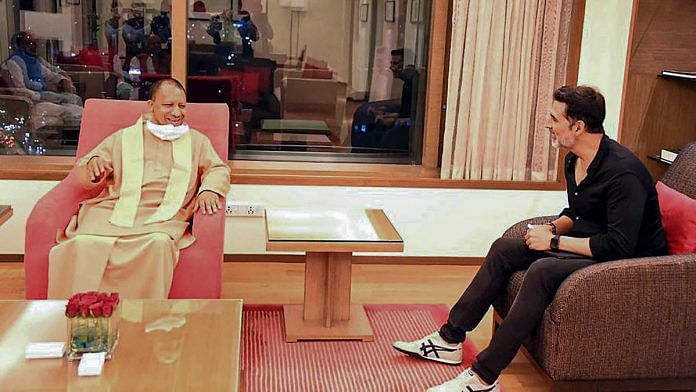Uttar Pradesh Chief Minister Yogi Adityanath’s recent Mumbai visit included a meeting with people from the film industry. His appeal to the film fraternity to consider developing Uttar Pradesh as a new hub for the entertainment industry has come under severe criticism from the state government led by the Shiv Sena. Party spokesperson Sanjay Raut advised the UP Chief Minister to visit other cities where the film industry is thriving. Taking a dig at Adityanath’s invitation to the doyens of Bollywood, the Shiv Sena had in October warned that it will not “tolerate” the shifting of Bollywood to UP.
Shiv Sena MP Sanjay Raut has said that it is not possible to replicate Mumbai Film City in any other state, especially in Lucknow or Patna. (“What is the status of Noida Film City now? Can you create Mumbai’s Film City in Lucknow and Patna? Earlier, attempts were made. It is difficult to replicate Mumbai’s film industry elsewhere. Mumbai has a glorious film history and past.”)
The Shiv Sena seems to have jumped the gun only to score brownie points. The UP Chief Minister has, meanwhile, taken the sting out of the criticism. “We are not snatching or hindering anyone’s investments. We’re not taking anything anywhere. Mumbai Film City will work in Mumbai itself, and a new Film City in UP is being developed in a new environment according to new requirements”, he said.
Also read: Yogi Adityanath bonds with businesses, Bollywood in Mumbai to attract investment to UP
Bollywood grew without Shiv Sena
Ironically, both film cities, Bollywood and the one in Noida, are creations of earlier governments and the current ones quarrelling over them have little or no claim over their success or failure. But, if a chief minister of a state visits the commercial capital of India with a view to scout for business, the Shiv Sena or for that matter any other political party should have no objections. The status of commercial capital was not bequeathed by the Shiv Sena on Mumbai. In fact, during the past, for several years, the party’s only contribution has been to create hurdles for the industry and the business by rising parochial and ‘job for locals only’ issues. The Shiv Sena would be well advised to remember that the growth of the film industry in Mumbai was not due to them but rather in spite of them. The cosmopolitan atmosphere in Mumbai and the work culture, the spirit of ‘never say die’ and the large-heartedness to accept ‘outsiders’ have all contributed to ensure that the city remains relevant.
The UP Chief Minister had announced in September this year that a grand film city with modern facilities will come up in Noida. It is not clear if this will be a new venture or extension of the existing one in Noida. In any case, it will require more land and much more investment than what Yogi Adityanath has in mind. If the Chief Minister is serious about improving the existing facility, he should do so at the earliest and extend concessions to filmmakers as part of his outreach policy.
Also read: UP govt lists Lucknow municipal body bonds worth Rs 200 crore at Bombay Stock Exchange
Film City’s larger plot
The entire exercise of developing a new film city appears to be part of improving the overall industrial situation of the state, bringing more business to the state, generating revenue and increasing employment opportunities. These are highly laudable policy goals and no one can really object if a chief minister is determined to improve the conditions in his or her state.
But touting UP as the ‘central point of culture’ and highlighting the fact that it connects with seven states of India and one foreign country, Nepal, does not make it an attractive investment and industry destination. There are a number of other parameters that contribute towards making any city or area a commercial zone and attract investors and industry.
Infrastructure, connectivity, availability of uninterrupted power and, above all, easy flow of labour and skilled workforce are some of the things that attract business besides, of course, a strong security environment. Laying the foundation for a state-of-the-art film city, by itself, may not attract other industries. Besides improving the law and order situation, the state will have to roll out a broad-based industrialisation blueprint, identify the strengths and plug the loopholes in its ambitious plan.
Manufacturing lies at the core of economic activity in any region. In UP, there are three Integrated Manufacturing Clusters (IMC) — Auraiya-Etawah-Kanpur, Allahabad-Varanasi and Agra-Aligarh — that need massive support to give a boost to the manufacturing sector in the state. Besides, there are a number of small pockets with limited connectivity that excel as MSME hubs and have cottage industry sectors. In keeping with the appeal made by Prime Minister Narendra Modi to be “vocal for local”, the state should encourage these industrial clusters and agro-based industries, which have greater capacity to provide employment and generate revenue with relatively lesser investment.
The author is the former editor of ‘Organiser’. Views are personal.







CM Ajay Bisht deserves praise for bringing Vikas back to the conversation about Uttar Pradesh.